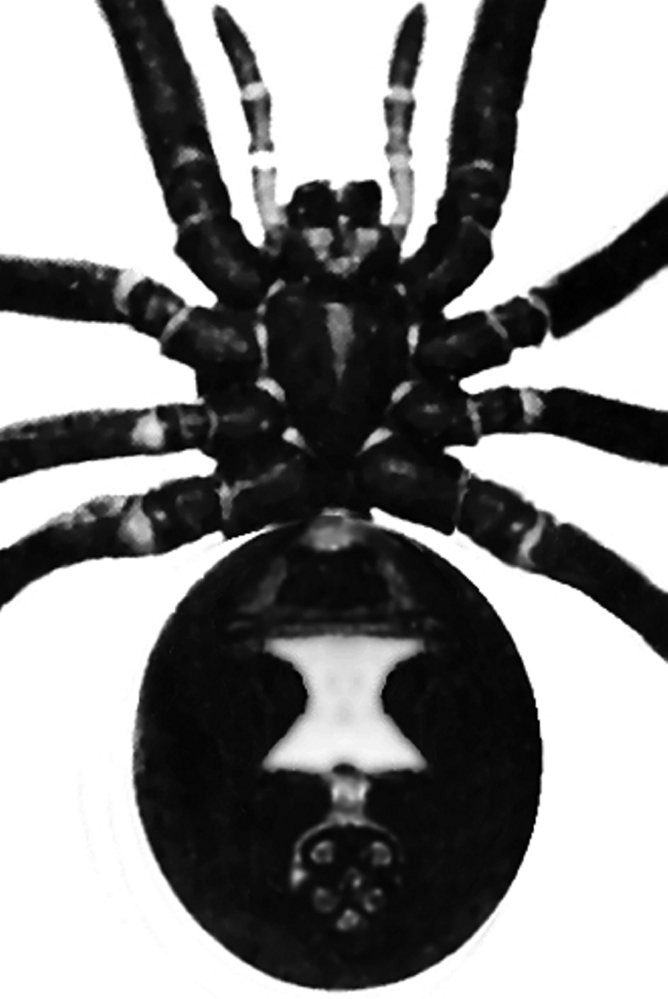My son Jack got annoyed with me a week or so ago about black widow spiders.
He was explaining to me over lunch that black widows — everyone’s favorite phrase to evoke arachnid peril — live in Maine.
I said, well, not exactly. But he insisted he’d read online that you can encounter them in Maine. There was no antidote to his fear.
Had he seen some new report? My understanding has been that while black widows are infrequently spotted here, they don’t live here because they can’t survive our fatally cold winters. A bunch of them turned up in some crates at Bath Iron Works a few years ago and caused a stir, but that apparently blew over. They all froze to death, no doubt.
Black widow spiders are in the same family of arachnids — Theridiidae, or comb-footed spiders — as the common house spiders you probably have spinning cobwebs in your basement. They’re roughly the same shape, with big butts and relatively long legs. The house spider’s technical name is Achaearanea tepidodariorum (or Parasteatoda tepidariorum), and they’re not the least bit dangerous to humans (except possibly in virtually unknown cases of allergic reaction).
The widow spiders are a different genus, Latrodectus. They’re identifiable by a red hourglass marking on their underside, which is a duller color among L. geometricus, the brown widow, and brighter red among L. mactans, the Southern black widow. They live mainly in the South because they’re not adapted to survive in cold weather. And they are, indeed, poisonous to humans.
Most spiders have side to side jaws called chelicerae with little fangs on the tips that can deliver venom to paralyze a victim (and turn the insides into mush that the spider sucks out). Most spiders are capable of biting people, but hardly any of them have fangs big enough for humans to even notice, never mind venom strong enough to affect you.
Most of the bites people — even doctors — attribute to spiders are probably not from spiders at all, according to the arachnologists. Often simple skin infections are mistaken for spider bites. And a lot of insects you didn’t even know were there can raise a welt, including fleas, flies, mosquitoes, blister beetles and more. Spiders, unlike many of these other monsters, are not trying to eat you. In fact, they’re almost always trying to get out of your way, and bite only when surprised — for example, when tangled up in your bedding.
A few spiders commonly found in Maine do have, on those surprise occasions, the capacity to make you remember the encounter, though the severity of the experience depends partly on your sensitivity to the venom. UMaine entomologist Don Barry told me that, among species common in Maine, some wolf spiders (Lycosidae) and some jumping spiders (Saliticidae), who both hunt rather than snare, can make an impression on you. But again, they get out of your way first and bite as a last resort.
A boogey-spider whose name evokes black-widow-like fear is the brown recluse, identified by a distinct violin shape on its back. Its venom can kill skin cells, raise a nasty, painful volcano of a wound, and in very unusual cases cause renal failure and death. Loxosceles reclusa, however, does not live in Maine, and is identified only rarely as a stowaway in luggage or shipping from south of here.
Years ago I had such a volcano-like bite hole that after a week or so hurt so much I went to the doctor, who speculated it was a brown recluse bite. In light of what the arachnologists say, though, if it was a spider, it was more likely a sac spider (family Clubionidae), some species of which do live here, who probably got scared while poking around in my shirt or sheets. Their venom contains a cytotoxin that can cause a painful, necrotizing wound like the one I had, but it’s not deadly. I still live.
Black widow bites, though, can be fatal. Their venom is a neurotoxin, meaning it’s poisonous to nerve tissue. The bite itself is by all accounts practically unnoticeable, but the neurotoxin eventually raises a dull ache around the wound that’s often followed by severe abdominal pain, muscle spasms, difficulty breathing, and in extreme cases death, though this is unusual, especially as there are antidotes — Barry says he thinks there hasn’t been a fatality from a black widow bite in about 50 years. Like virtually all spiders, the black widows avoid you first and bite last. In fact, as spiders go, they’re relatively shy and retiring.
So should Jack be living in black widow fear?
Barry, who keeps track of stuff like this, told me black widows, when they do appear in Maine, have traveled from points south and are not living here.
For now, at least.
“We get a half dozen in my office, or so, each year from grocery store grapes, mostly L. hesperus, the western widow, and occasionally a brown widow,” he said.
“The last widow we caught in Maine, in the wild,” he added, “was found in a rodent bait station behind the Wal-Mart in Newport about five years ago. It was considered a hitchhiker. For myself, I’ve never seen one outdoors in Maine and I think it’s wrong to say that they are established in the state. If winters moderate in the future, they certainly may become established, but any we find these days are likely visitors from out-of-state.”
So running across a black widow spider in Maine is not impossible, but it’s very unlikely, because they don’t live here and they stay out of your way.
The real annoyance is the fear.
Dana Wilde lives in Troy. He is a contributor to “Pluto: New Horizons for a Lost Horizon” available from North Atlantic Books. You can contact him at naturalist1@dwildepress.net. Backyard Naturalist appears the second and fourth Thursdays each month.
Send questions/comments to the editors.



